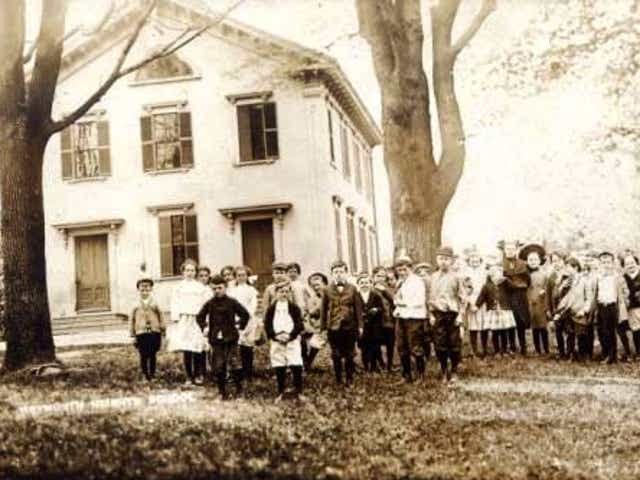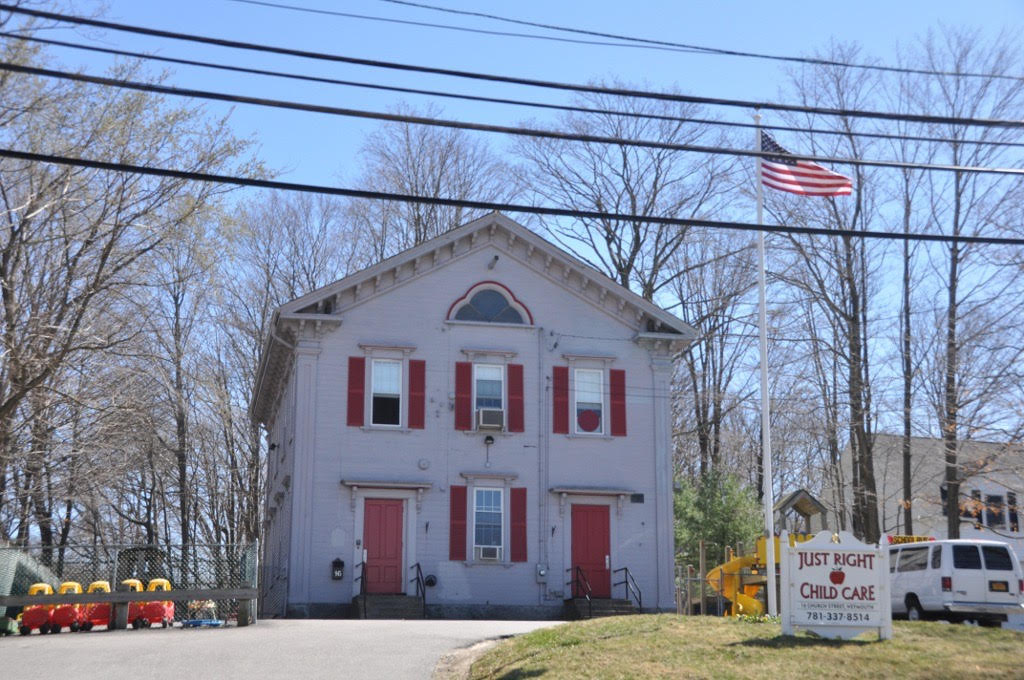
Our mailbox is bustling this week and even better many of the comments come from dear friends whom I have known for over half a century. In fact, the photo above is from where Mark attended school — the Abigail Adams Schoolhouse — while growing up in Weymouth Massachusetts. We met at Manhattan College in the Bronx and I gained a lifelong friend.
Many of the comments connected with our post on hope as an attribute that makes a big difference ;see Hope IS a strategy. I contended HOPE deserves more attention in formative assessments to help students and adult learners succeed.
Joseph, whom I hope to bring back when we get into our discussion of universities and assessments, wrote:
“You have provoked, I believe, with your discourse on hope, an energizing and possibly enlightening (for me, anyway) discussion! Given how I’ve perceived the word’s use, I’ve often thought it to be a sort of cheerful though wishy-washy word ( as in wishing something will come to pass). Were this true, its meaning in terms of intention would be possibly a rung down from what Peale years ago termed “positive thinking.” Snyder’s definition, however, definitely makes hope definite, powerful and an active agent in stimulating effect. If this be true, isn’t the proverbial statement of, “I hope not” made in rejoinder to some possibly non desirous impending event (over which one may have absolutely no control) a misuse of the word? Snyder’s definition of hope goes beyond wishing and beyond also positive thinking. The word closest to that kind of hope that readily comes to my mind is “expect.” And, as mentioned, Snyder goes beyond expect by adding “effect,” as in, “I expect (something) to happen and I will see to its effect.” If this is true, then hope, both in noun and verb, imply immense powerful, right up there with “create”…I expect.”
Our wonderfully dependable correspondent, Marianne Talbot, commented:
“This resonates with me in relation to my doctoral work, which is just getting underway. I am researching the impact of a specific form of post-qualification professional development on the teachers who undertake it: Chartered Educational Assessors or CEAs. This breaks down into what influence becoming chartered has had on their assessment literacy and practice, how it has influenced others they work with, and how it has influenced the organisations they work for. Confidence, motivation, self-efficacy and self-regulation (as well as many other factors) all feed into this, and I think the idea of hope could be a powerful thing to investigate further. I suspect that ‘successful’ CEAs have high levels of hope but so far have no evidence for this hypothesis! They probably also have high levels of conscientiousness, as described in yesterday’s blog. Hope and conscientiousness, I think, are infectious and can therefore spread from one individual to another and throughout a team or organisation. At least, that’s what I hope…”
One very wise friend expanded on hope in this manner:
“Positive outlook, glass half full (or as an engineer might say, its just the wrong size of glass and fixing that would make it full)
Persistence counts more than hope, or perhaps, one must have hope to be persistent.
One must believe it can be done (finding a dime size dark colored rubber seal for a toy water rocket at the waters edge in the sea, yes, with waves going in and out)
Assuming the that people mean well rather than mean you ill, but as my Yoga teacher says, there is a dark side too (spoken like a true New Yorker)
Hope is tied to loss control. If you don’t master that, life goes downhill, and there is no hope. Like paying your car insurance on time (so a simple traffic stop does not mean they tow your car off and lack of car means you lose your job…), locking your front door when you leave for the day. Being polite to people. Helping others out which means they will help you in time of need.
Having positive goals is tied back into hope.
Leaving as many doors open in life as you can and closing as few as possible behind you.
I tell my clients (not all of them, those were it fits) that I am there to give them hope, hope that we can solve what seem to be intractable problems, hope that we can find and fix the root cause…
Hope is the antidote to worry. I don’t worry. I skip that worry thing. If there is an issue, I am concerned and take action. I don’t worry there might be an issue.
[Quoting Snyder] “Simply put, hopeful thought reflects the belief that one can find pathways to desired goals and become motivated to use those pathways. … that hope, so defined, serves to drive the emotions and well-being of people.”
People who worry are not happy people.
Over on LinkedIn, someone I first met in the 1970s and who now runs a really compelling consulting practice, Tom Sullivan, and I had this useful exchange after our post, The ‘people should judge people, not tests’ take ignores our biases especially when they come into play in those ‘tests’ that we call job interviews.
Tom: In my work, I help organizational leaders make good people decisions. Whether it’s selecting the right candidate, assessing for future talent, or creating a succession plan, it’s all about human decisions. And yes, that comes with an onslaught of biases, cognitive distortions and thinking errors. Including reliable and valid testing offers an equalizing data point. It serves as a neutralizer when ours brains lie to us.
T.J.: And having a coach for such decisions proves extraordinarily valuable. As Richard Feynman once said, “The first thing is not to fool yourself, and you are the easiest person to fool.“ Having someone to question your take matters. But that happens too rarely, doesn’t it?
Tom: As much as we think we value independent critical thinking and encourage healthy debate and challenge, it comes at a price in organizational life.
T.J.: So true, Tom. Groupthink lives! 😉
And Marianne again made a winning point with a fascinating quote embedded in her comment here related to cognitive bias:
“Bias is great, isn’t it? I could go on for hours, days, weeks. There is just so much of it. It is everywhere. But we mostly tend to ignore it. I particularly enjoy/suffer from the planning fallacy (myself), and the status quo bias (other people, never myself, of course).
Just to be provocative, take this quote from a Cambridge Assessment article by John Rust – my emphasis added (from 2007, available here: https://www.cambridgeassessment.org.uk/Images/505311-discussion-piece-the-psychometric-principles-of-assessment.pdf – sorry it looks like I’m shouting):
“But latterly there has been an increased recognition that, apart from item level bias, MOST OF THE BIAS FOUND IN ASSESSMENT IS EXTRINSIC TO THE TEST OR EXAMINATION ITSELF. More often, differences in test scores between groups come about as a result of the impact of real differences in society. Bias in, and the consequent adverse impact of, school examination results CAN TO A LARGE EXTENT BE ACCOUNTED FOR BY DIFFERENCES BETWEEN LOCALITIES IN THE QUALITY OF SCHOOLING, OR OF PARENTAL, PEER AND TEACHER EXPECTATION AND SUPPORT. These are themselves dependent on the impact of social policy on local demographics.”
I am not sure this is true – any more? – it might have been what was BELIEVED at the time, but I’d like to think society has moved on a bit in the last 15 years – but education will likely take a while to catch up”
What do others think? Have we eliminated bias in assessment especially from sources extrinsic to the test? Love to hear the opinions of our audience on that one.
And our blog prompted Rich whom I met in 1965 to relate the story of the rogue Rhodes scholar that had this line in it
“2021-2022 essay prompts from Common App, the organization that oversees undergrad applications for more than 900 schools, include “Recount a time when you faced a challenge, setback, or failure.”
That prompted a university professor in the South who I knew as a low-key track team captain and swift miler in the 1960s but more recently says he “served on our university internal selection panel for several years” to write that
“As near as I can tell fabrication of one’s life story is not a valid reason for rejection since it is not necessarily contrary to the four criteria for selection ( https://www.rhodeshouse.ox.ac.uk/office-of-the-american-secretary/application-overview/frequently-asked-questions/). The young lady deserves praise for her creativity and success in capturing the essence of success in a world where identity is created out of whole cloth and it is OK to do whatever it takes to become rich and/or famous. At least until you get caught like Elizabeth Holmes. In which case you blame abuse as the reason you lied which would bring McKenzie Fierceton full circle.”
It’s worth noting that the Jesuits who taught us were masters in sarcasm.
The above comments reminded me of a recent excellent article, The Case against the Trauma Plot, in the New Yorker by Parul Seghal
I like very much this passage from her article, which has nothing to do with testing or learning:
“Trauma has become synonymous with backstory, but the tyranny of backstory is itself a relatively recent phenomenon—one that, like any successful convention, has a way of skirting our notice. Personality was not always rendered as the pencil-rubbing of personal history. Jane Austen’s characters are not pierced by sudden memories; they do not work to fill in the gaps of partial, haunting recollections.”
And finally thanks to Tom whom I already owe so much because he left his record collection and turntable with us while he gallivanted around the USA in the summer of 1972, we have our first submitted joke to the blog.
“Three statisticians went out hunting, two with guns and one with field glasses. One took a shot at a rabbit, and the spotter said “a foot to the left!” The second hunter got off a shot at the fast moving rabbit, and the spotter said “a foot to the right! You got it!”
Ah, the tyranny of averages! Speaking of tyranny, tomorrow we return to the SAT.
I kid the College Board. BTW, on average a couple of hundred people have vewed each post so far during the January Jolts, but over in LinkedIn 2,260 people viewed the post on validity. Not too shabby. Please consider reposting our stuff. The idea is to raise awareness about testing so that we do it in a better way for everyone.

So great to read others’ thoughts on these interesting topics, as always it’s an honour and a privilege to be able to take part in such conversations. Nothing new to contribute, but happy to share a visual assessment joke:
https://www.reddit.com/r/technicallythetruth/comments/ab7le0/sad_plant/
I love this cartoon